Index to Trees & Shrubs in the Order Ericales
Family: Ebenaceae (Ebony Family)
605. Diospyros lycioides Bluebush viewtopic.php?p=526944#p526944
606. Diospyros mespiliformis Jackal-berry viewtopic.php?f=248&t=3767&p=171462#p171462
594. Euclea crispa crispa Blue Guarri viewtopic.php?p=224327#p224327
599. Euclea racemosa Sea Guarri, Dune Guarri viewtopic.php?p=248864#p248864
601. Euclea undulataCommon Guarri, Small-leaved Guarri viewtopic.php?p=261063#p261063
Family: Lecythidaceae
524. Barringtonia racemosa Powderpuff Tree viewtopic.php?p=321821#p321821
Family: Sapotaceae
581. Englerophytum magalismontanum Transvaal Milkplum, Stamvrug viewtopic.php?p=530953#p530953
Africa Wild Tree & Shrub Book - Order Ericales
Moderator: Klipspringer
Re: Africa Wild Tree & Shrub Book - Order Ericales
606. Jackal-berry Diospyros mespiliformis (Jakkalsbessie)
Order: Ericales. Family: Ebenaceae
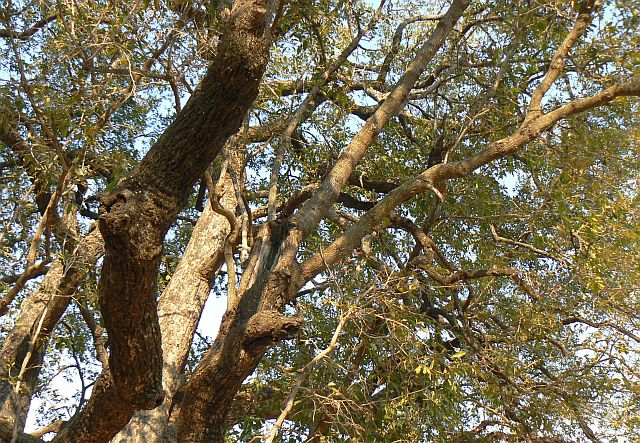
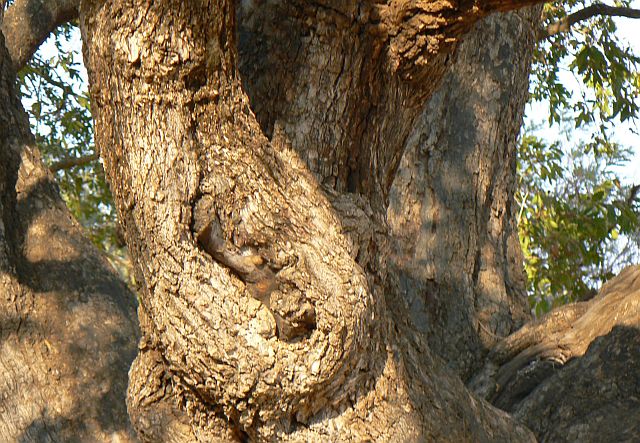
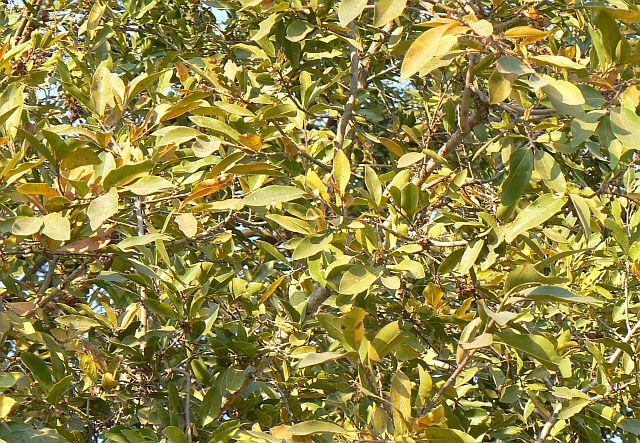
Kruger National Park

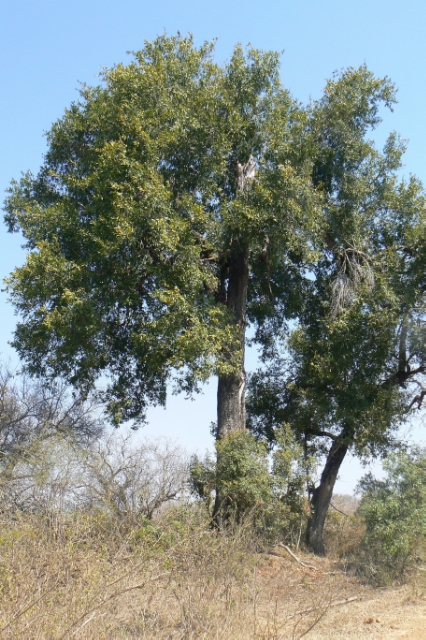
Kruger National Park, H2-2
Description
A tall, upright tree that can reach a height of 25 m, with a trunk circumference of more than 5 m, rounded and buttressed stem. It has a dense evergreen canopy. The bark is black to grey, with a rough texture, smooth in young trees rough with small regular scales in older trees, pinkish when slashed. The fresh inner skin of the bark is reddish. Leaves are simple, alternate, leathery and dark green. The margin is smooth and new leaves in spring are red, especially in young plants. Flowers are cream-coloured and bell-shaped. Male flowers are arranged in stalked bunches and female flowers are solitary. Fruits usually globose, fleshy, up to 3 cm in diameter, greenish and pubescent when young, yellowish to orange yellow and glabrous when ripe, bell shaped, with persistent style and enlarged calyx and contain 4-6 seeds. Seeds, dark brown, bean-shaped shiny and glabrous.
Distribution
Widely distributed throughout the eastern part of the African continent, from Ethiopia to the south of Swaziland. Native to Angola, Botswana, Eritrea, Ethiopia, Guinea, Kenya, Namibia, Nigeria, South Africa, Sudan, Swaziland, Tanzania, Uganda, Yemen, Zambia, Zimbabwe.
Habitat
It grows mostly in savanna and woodland, often on termite hills.
Links: Wild About Trees; Ernst Schmidt, Mervyn Lotter,Warren McCleland: Trees and Shrubs of Mpumalanga and Kruger National Park
Order: Ericales. Family: Ebenaceae



Kruger National Park


Kruger National Park, H2-2
Description
A tall, upright tree that can reach a height of 25 m, with a trunk circumference of more than 5 m, rounded and buttressed stem. It has a dense evergreen canopy. The bark is black to grey, with a rough texture, smooth in young trees rough with small regular scales in older trees, pinkish when slashed. The fresh inner skin of the bark is reddish. Leaves are simple, alternate, leathery and dark green. The margin is smooth and new leaves in spring are red, especially in young plants. Flowers are cream-coloured and bell-shaped. Male flowers are arranged in stalked bunches and female flowers are solitary. Fruits usually globose, fleshy, up to 3 cm in diameter, greenish and pubescent when young, yellowish to orange yellow and glabrous when ripe, bell shaped, with persistent style and enlarged calyx and contain 4-6 seeds. Seeds, dark brown, bean-shaped shiny and glabrous.
Distribution
Widely distributed throughout the eastern part of the African continent, from Ethiopia to the south of Swaziland. Native to Angola, Botswana, Eritrea, Ethiopia, Guinea, Kenya, Namibia, Nigeria, South Africa, Sudan, Swaziland, Tanzania, Uganda, Yemen, Zambia, Zimbabwe.
Habitat
It grows mostly in savanna and woodland, often on termite hills.
Links: Wild About Trees; Ernst Schmidt, Mervyn Lotter,Warren McCleland: Trees and Shrubs of Mpumalanga and Kruger National Park
Re: Africa Wild Tree & Shrub Book - Order Ericales
594. Blue Guarri Euclea crispa crispa (Bloughwarrie)
Order: Ericales. Family: Ebenaceae
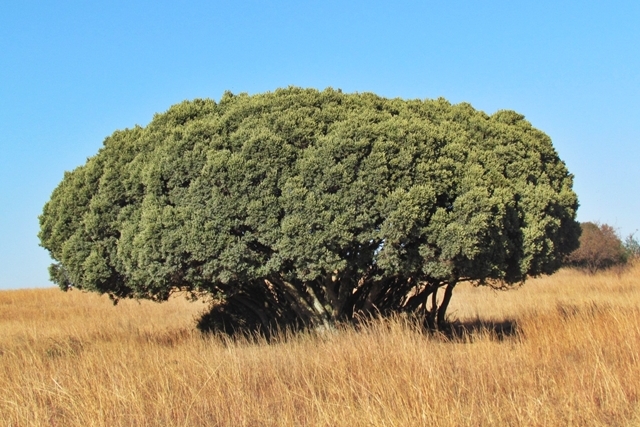 © Flutterby
© Flutterby
Rietvlei Nature Reserve, Gauteng
Description
A rounded, dense and bushy shrub or tree, reaching a height of 2 to 6 m (rarely 8 to 20 m), with a spreading, often symmetrical crown. It is slow-growing like its congeners, and becomes frost and drought resistant with age. Sometimes forming small, dense colonies.
The bole is single or multi-stemmed and up to 30 cm in diameter. The wood is dark brown, hard and close-grained. The bark varies from grey to brown or blackish, and is smooth in young trees, but rougher in older trees.
The plants carry a dense canopy of simple leaves of a dull grey-green colour and a rigid, leathery lineament. Foliage colour varies from a greyish green to distinctly blue, and the leaf shape varies from lanceolate to obovate. Leaves variable but hardly wavy, broadly tapering with rounded apex, or acute apex with rounded tip, margins entire. New branches and foliage are covered in rust-brown scales (gland granules), while mature leaves may be hairy or glabrous. Leaves may be opposite, sub-opposite or rarely alternate. The slender petiole is 1.5 to 2 mm long, and the leaves measure up to 5 x 1.5 cm. The leaf veins are clear and transparent against light, unlike the opaque venation of Wild olive trees.
The fragrant flowers are produced in summer, from October to February. They are small, waxy, pendulous, yellow to greenish-white and borne in axillary pseudo-racemes, holding 3 to 10 flowers each. Their bell-shaped corollas are deeply lobed, and the ovaries are densely covered in bristles.
The roundish, pea-sized berries (4 to 5 mm in diameter) are considered palatable when ripe. They are single-seeded and borne on female trees only. As they ripen, they turn from green to reddish brown, and eventually to black. They are somewhat or very hairy when green, but more or less glabrous when mature. Saplings can be grown quite easily from fresh, plump seed, that is sown soon after harvesting.
Distribution
Widely distributed in southern Africa. This evergreen tree is indigenous to Southern Africa and has a wide natural distribution range, from the Eastern Cape, up the KwaZulu-Natal coast and further northwards past South Africa's northern border.
Habitat
Occurring in bushveld, sheltered places in grassland, forest margins and often in rocky places on both north- and south-facing slopes.
Links: PlantZAfrica; Trees and Shrubs of Mpumalanga and Kruger National Park
Order: Ericales. Family: Ebenaceae
 © Flutterby
© FlutterbyRietvlei Nature Reserve, Gauteng
Description
A rounded, dense and bushy shrub or tree, reaching a height of 2 to 6 m (rarely 8 to 20 m), with a spreading, often symmetrical crown. It is slow-growing like its congeners, and becomes frost and drought resistant with age. Sometimes forming small, dense colonies.
The bole is single or multi-stemmed and up to 30 cm in diameter. The wood is dark brown, hard and close-grained. The bark varies from grey to brown or blackish, and is smooth in young trees, but rougher in older trees.
The plants carry a dense canopy of simple leaves of a dull grey-green colour and a rigid, leathery lineament. Foliage colour varies from a greyish green to distinctly blue, and the leaf shape varies from lanceolate to obovate. Leaves variable but hardly wavy, broadly tapering with rounded apex, or acute apex with rounded tip, margins entire. New branches and foliage are covered in rust-brown scales (gland granules), while mature leaves may be hairy or glabrous. Leaves may be opposite, sub-opposite or rarely alternate. The slender petiole is 1.5 to 2 mm long, and the leaves measure up to 5 x 1.5 cm. The leaf veins are clear and transparent against light, unlike the opaque venation of Wild olive trees.
The fragrant flowers are produced in summer, from October to February. They are small, waxy, pendulous, yellow to greenish-white and borne in axillary pseudo-racemes, holding 3 to 10 flowers each. Their bell-shaped corollas are deeply lobed, and the ovaries are densely covered in bristles.
The roundish, pea-sized berries (4 to 5 mm in diameter) are considered palatable when ripe. They are single-seeded and borne on female trees only. As they ripen, they turn from green to reddish brown, and eventually to black. They are somewhat or very hairy when green, but more or less glabrous when mature. Saplings can be grown quite easily from fresh, plump seed, that is sown soon after harvesting.
Distribution
Widely distributed in southern Africa. This evergreen tree is indigenous to Southern Africa and has a wide natural distribution range, from the Eastern Cape, up the KwaZulu-Natal coast and further northwards past South Africa's northern border.
Habitat
Occurring in bushveld, sheltered places in grassland, forest margins and often in rocky places on both north- and south-facing slopes.
Links: PlantZAfrica; Trees and Shrubs of Mpumalanga and Kruger National Park
Re: Africa Wild Tree & Shrub Book - Order Ericales
599. Sea Guarri, Dune Guarri Euclea racemosa (Seeghwarrie)
Order: Ericales. Family: Ebenaceae
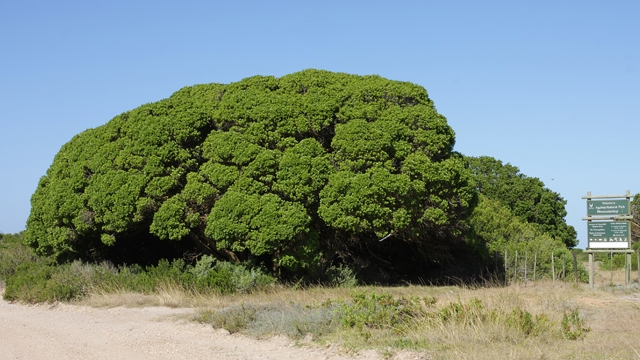 © leachy
© leachy
Agulhas National Park, Resnosterkop
Description
A small to medium-sized evergreen tree or shrub, with densely-branched, umbrella-shaped crown, growing 2 - 6 m tall. The bark is grey, smooth, branchlets often reddish. It has leathery foliage that can be exceptionally even and dense - making it an ideal plant for hedges. The leaves are spirally arranged, opposite, varying in shape, paler green below than above, margin rolled under. A dioecious tree (male and female flowers on separate trees), it produces small flowers, creamy-white bells, in small bunches from leaf axils, Dec. - March. Flowers are followed by red, purple and black fruits that attract birds. Fruits are spherical, thinly fleshy berry,red at first, black when mature, Feb. – May.
Distribution
Indigenous to the Indian Ocean coast of Africa from Egypt to South Africa.
Subspecies:
Euclea racemosa bernardii - Cape Province
Euclea racemosa daphnoides - Cape Province, KwaZulu-Natal, Swaziland, Mpumalanga, Limpopo
Euclea racemosa macrophylla - Cape Province, KwaZulu-Natal
Euclea racemosa racemosa - Cape Province
Euclea racemosa schimperi - most of species range
Euclea racemosa sinuata - Mozambique, KwaZulu-Natal
Euclea racemosa zuluensis - Swaziland, Mozambique, KwaZulu-Natal
Habitat
Dune shrub and coastal forest.
Order: Ericales. Family: Ebenaceae
 © leachy
© leachyAgulhas National Park, Resnosterkop
Description
A small to medium-sized evergreen tree or shrub, with densely-branched, umbrella-shaped crown, growing 2 - 6 m tall. The bark is grey, smooth, branchlets often reddish. It has leathery foliage that can be exceptionally even and dense - making it an ideal plant for hedges. The leaves are spirally arranged, opposite, varying in shape, paler green below than above, margin rolled under. A dioecious tree (male and female flowers on separate trees), it produces small flowers, creamy-white bells, in small bunches from leaf axils, Dec. - March. Flowers are followed by red, purple and black fruits that attract birds. Fruits are spherical, thinly fleshy berry,red at first, black when mature, Feb. – May.
Distribution
Indigenous to the Indian Ocean coast of Africa from Egypt to South Africa.
Subspecies:
Euclea racemosa bernardii - Cape Province
Euclea racemosa daphnoides - Cape Province, KwaZulu-Natal, Swaziland, Mpumalanga, Limpopo
Euclea racemosa macrophylla - Cape Province, KwaZulu-Natal
Euclea racemosa racemosa - Cape Province
Euclea racemosa schimperi - most of species range
Euclea racemosa sinuata - Mozambique, KwaZulu-Natal
Euclea racemosa zuluensis - Swaziland, Mozambique, KwaZulu-Natal
Habitat
Dune shrub and coastal forest.
Re: Africa Wild Tree & Shrub Book - Order Ericales
601. Common Guarri, Small-leaved Guarri Euclea undulata (Kleinblaarghwarrie)
Order: Ericales. Family: Ebenaceae
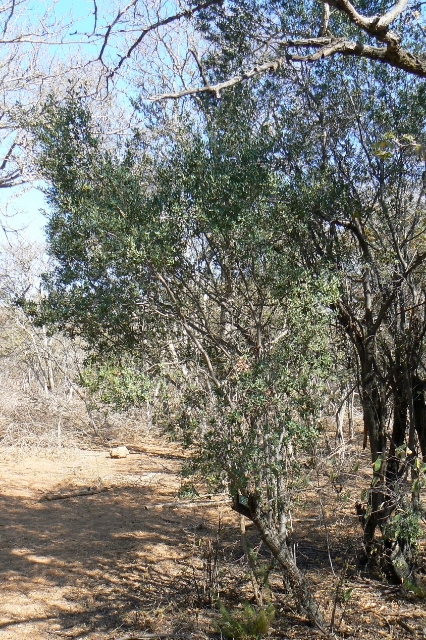
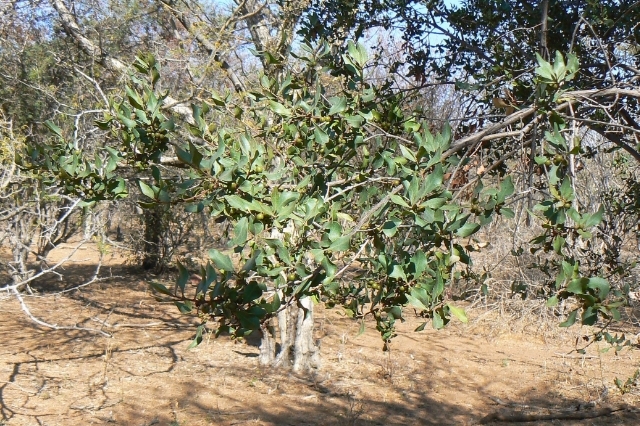
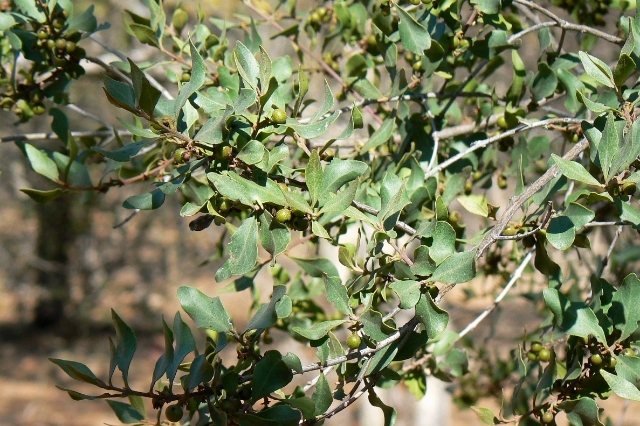
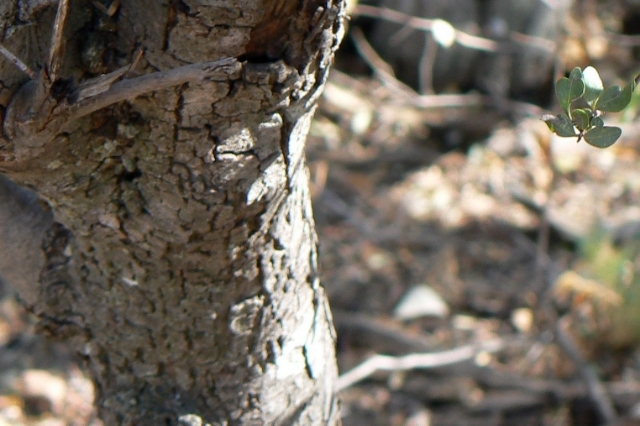 © Toko
© Toko
Marakele National Park
Description
Euclea undulata is a very sturdy, evergreen, dense and twiggy shrub to small tree reaching an approximate size of 7 m in height and very often with an equal width. The bushy and rounded appearance of the trees is due to the numerous branches that carry the closely packed leaves on stems that often reach ground level, giving an appearance of large dark green mounds or domes in the landscape. Several specimens commonly grow closely together, and in such cases they can form impenetrable thickets, as is often the case in their southern to coastal distribution range.
The leaves are opposite to subopposite or may be arranged in whorls of 3 or 4, mostly towards the ends of branchlets. Leaves are small, obovate to narrowly elliptical, 20–40 x 5–15 mm, stiff, leathery, dark green or blue-green above, paler below and sometimes rusty brown. The leaf apex is broadly tapering, or rounded to abruptly attenuate, base tapering, margin entire, finely rolled under, conspicuously wavy, or almost flat; petiole 1–3 mm long.
The bark is grey, scaly longitudinally fissured or cracked, particularly with age. The branchlets are twiggy, angular and densely leafy with short internodes
Flowers are small, whitish to cream, carried on unbranched 5- to 7-flowered spikes of up to 20 mm length, hairless but with rust-coloured stalked glands. The spikes are solitary in the leaf axils and are somewhat scented, appearing from December to May.
Fruits appear from February and are single-seeded rounded berries, 4–7 mm in diameter, thinly fleshy, reddish brown becoming dark when ripe, in short sprays less than 12 mm long. In adult plants flowers and fruits commonly occur simultaneously, resulting in prolonged presence of fruit or flowers or both for most of the year.
Distribution
The species is found widespread over southern Africa, especially in South Africa (Eastern Cape, Free State, Gauteng, KwaZulu-Natal, Limpopo, Mpumalanga, Northern Cape, North West, Western Cape), Mozambique, Zimbabwe, Botswana and Namibia.
Habitat
It favours open rocky slopes, low hills with valleys, open mopane/acacia woodland, watercourses and areas with frequent or scattered termite mounds commonly referred to as heuweltjies' (little hills). In South Africa these trees can be found almost throughout the country with the exception of the central interior associated with high altitude habitats. it is generally associated with rocky rather than deep sandy habitats. This fact, rather than the altitude, is probably the main reason why the species is absent in parts of the Kalahari with deep sand.
Links: Sappi Tree Spotting: Kwazulu-Natal and Eastern Cape. Val Thomas, Rina Grant
Order: Ericales. Family: Ebenaceae



 © Toko
© TokoMarakele National Park
Description
Euclea undulata is a very sturdy, evergreen, dense and twiggy shrub to small tree reaching an approximate size of 7 m in height and very often with an equal width. The bushy and rounded appearance of the trees is due to the numerous branches that carry the closely packed leaves on stems that often reach ground level, giving an appearance of large dark green mounds or domes in the landscape. Several specimens commonly grow closely together, and in such cases they can form impenetrable thickets, as is often the case in their southern to coastal distribution range.
The leaves are opposite to subopposite or may be arranged in whorls of 3 or 4, mostly towards the ends of branchlets. Leaves are small, obovate to narrowly elliptical, 20–40 x 5–15 mm, stiff, leathery, dark green or blue-green above, paler below and sometimes rusty brown. The leaf apex is broadly tapering, or rounded to abruptly attenuate, base tapering, margin entire, finely rolled under, conspicuously wavy, or almost flat; petiole 1–3 mm long.
The bark is grey, scaly longitudinally fissured or cracked, particularly with age. The branchlets are twiggy, angular and densely leafy with short internodes
Flowers are small, whitish to cream, carried on unbranched 5- to 7-flowered spikes of up to 20 mm length, hairless but with rust-coloured stalked glands. The spikes are solitary in the leaf axils and are somewhat scented, appearing from December to May.
Fruits appear from February and are single-seeded rounded berries, 4–7 mm in diameter, thinly fleshy, reddish brown becoming dark when ripe, in short sprays less than 12 mm long. In adult plants flowers and fruits commonly occur simultaneously, resulting in prolonged presence of fruit or flowers or both for most of the year.
Distribution
The species is found widespread over southern Africa, especially in South Africa (Eastern Cape, Free State, Gauteng, KwaZulu-Natal, Limpopo, Mpumalanga, Northern Cape, North West, Western Cape), Mozambique, Zimbabwe, Botswana and Namibia.
Habitat
It favours open rocky slopes, low hills with valleys, open mopane/acacia woodland, watercourses and areas with frequent or scattered termite mounds commonly referred to as heuweltjies' (little hills). In South Africa these trees can be found almost throughout the country with the exception of the central interior associated with high altitude habitats. it is generally associated with rocky rather than deep sandy habitats. This fact, rather than the altitude, is probably the main reason why the species is absent in parts of the Kalahari with deep sand.
Links: Sappi Tree Spotting: Kwazulu-Natal and Eastern Cape. Val Thomas, Rina Grant
Re: Africa Wild Tree & Shrub Book - Order Ericales
524. Powderpuff Tree Barringtonia racemosa (Poeierkwasboom)
Order: Ericales. Family: Lecythidaceae

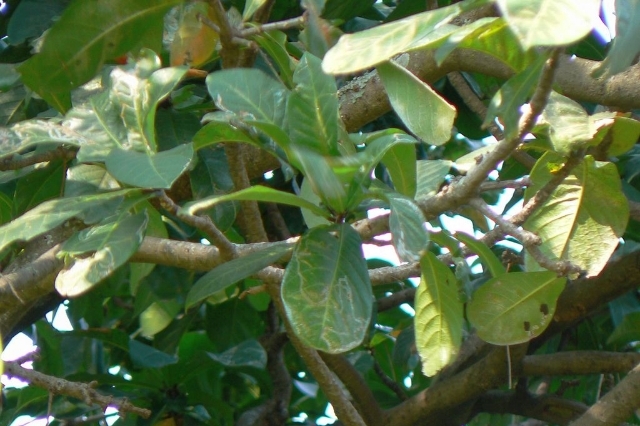
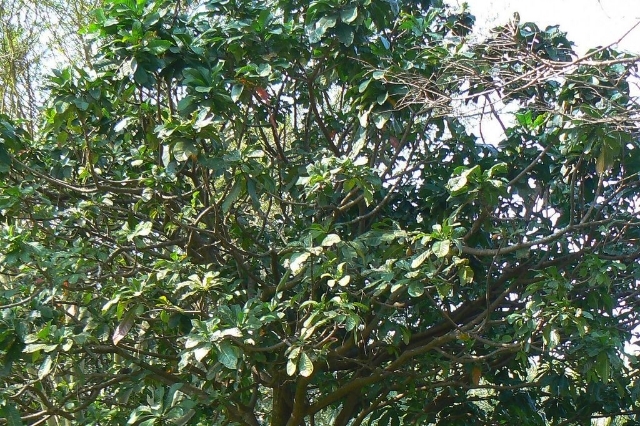
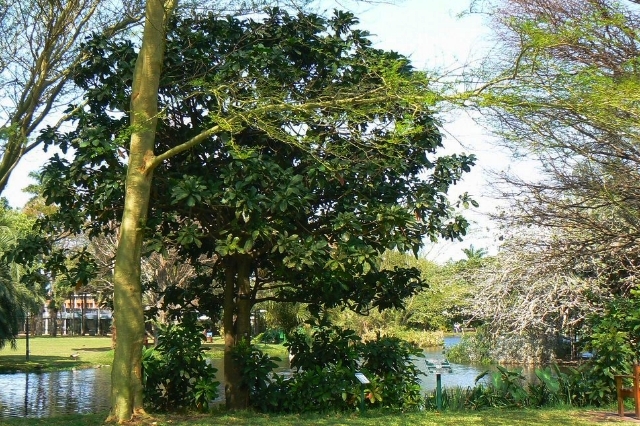
Durban
Description
Small to medium-sized tree. Barringtonia racemosa has a straight, unbranched stem that leads to a rounded crown and it is usually 4 to 8 m tall, but occasionally reaches 15 m. The bark is greyish brown to pink with white blotches and raised dots and lines. The branches are marked with leaf scars.
The flowers are produced on hanging racemes up to 1 m long. The buds are pinkish red and split open to bring forth masses of delicate stamens in white sprays up to 35 mm wide, which are often tinged with pink. The flowers emit a pungent, putrid yet faintly sweet odour in the morning. The fruit is quadrangular, 65 x 40 mm. Each fruit contains a single seed surrounded by spongy, fibrous flesh that provides the buoyancy that allows the fruit to be carried off with the tide.
Distribution
It is common along tropical and subtropical coasts in the Indian Ocean, starting at the east coast of South Africa. It is also widespread in Mozambique, Madagascar, India, Sri Lanka, Malaysia, Thailand, Laos, southern China, northern Australia, the Ryukyu Islands of Japan and a number of Polynesian islands.
Habitat
Barringtonia racemosa is mainly a coastal species that thrives under very humid, moist conditions. It is considered a mangrove associate, can also be found in tropical rainforest areas, open lowlands and thickets. Occurring always near water: along riverbanks and in freshwater swamps, and occasionally in the less saline areas of mangrove swamps, where it may develop pneumatophores.
Order: Ericales. Family: Lecythidaceae




Durban
Description
Small to medium-sized tree. Barringtonia racemosa has a straight, unbranched stem that leads to a rounded crown and it is usually 4 to 8 m tall, but occasionally reaches 15 m. The bark is greyish brown to pink with white blotches and raised dots and lines. The branches are marked with leaf scars.
The flowers are produced on hanging racemes up to 1 m long. The buds are pinkish red and split open to bring forth masses of delicate stamens in white sprays up to 35 mm wide, which are often tinged with pink. The flowers emit a pungent, putrid yet faintly sweet odour in the morning. The fruit is quadrangular, 65 x 40 mm. Each fruit contains a single seed surrounded by spongy, fibrous flesh that provides the buoyancy that allows the fruit to be carried off with the tide.
Distribution
It is common along tropical and subtropical coasts in the Indian Ocean, starting at the east coast of South Africa. It is also widespread in Mozambique, Madagascar, India, Sri Lanka, Malaysia, Thailand, Laos, southern China, northern Australia, the Ryukyu Islands of Japan and a number of Polynesian islands.
Habitat
Barringtonia racemosa is mainly a coastal species that thrives under very humid, moist conditions. It is considered a mangrove associate, can also be found in tropical rainforest areas, open lowlands and thickets. Occurring always near water: along riverbanks and in freshwater swamps, and occasionally in the less saline areas of mangrove swamps, where it may develop pneumatophores.
-
Klipspringer
- Global Moderator
- Posts: 5858
- Joined: Sat Sep 14, 2013 12:34 pm
- Country: Germany
- Contact:
Re: Africa Wild Tree & Shrub Book - Order Ericales
605. Bluebush Diospyros lycioides
umNqandane (Zulu), umBhongisa (Xhosa), Muthala (Venda), moNkga-nku (Sesotho), leHlajwa (Sesotho), bloubos (Afr.)
Order: Ericales. Family: Ebenaceae
Karoo National Park, March 2016: Diospyros lycioides ssp. lycioides, the Karoo Bluebush © nan
Description
A deciduous to evergreen shrub to medium tree up to 5 m tall with an open crown and drooping branches. It may also be a multi-stemmed shrub. The dark grey Bark is and relatively smooth. Young stems are often hairy. Branches grow upright. No milky sap or thorns are present.
It has blue-green leaves arranged spirally at the ends of the branches.
It bears tiny creamy yellow bell-shaped flowers, sweetly fragrant especially at night. The flowers attract lots of insects, especially bees, and also insectivorous bird. It flowers from September to December,
The fruit is a berry (pulpy, indehiscent fruit like a grape or tomato) with a jelly like flesh. It has a short, sharp tip and is almost spherical or ovoid (solid that is an oval in outline). The fruit is up to 2cm long. It turns an attractive red then light brown to black and is hard when mature, losing all its hairs in the process. The fruit contains tannins and is usually avoided by animals until the fruit is ripe and the tannin level decrease. The 5 persistent Calyx lobes are initially green and accrescent. They become folded back and each is eventually up to 1,5cm long. A persistent style may be visible on the young fruit. The mature fruit dehisces slowly and old fruit may remain on the tree until at least the next flowering season. Up to 6 Seeds are produced and each is brown, smooth and has a nearly straight-line groove. (Jan–May).
Distribution
The bluebush is the most widely distributed member of the genus Diospyros, growing in its various forms all over southern Africa with the exception of the winter-rainfall area of the Cape, parts of Botswana and eastern Namibia.
Habitat
It prefers rocky habitats and well-drained soils, but is also found along stream banks. It can be thicket-forming.
4 subspecies are recognized differing mainly in leaf form and distribution:
– subsp. lycioides (Karoo bluebush): shrub or small tree up to 7 m tall; branchlets spreading at right angles or slightly ascending at the ends, occasionally spinescent; leaves crowded towards the tips, blade up to 4 cm × 1.5 cm, glabrous or slightly velvety, lateral veins not raised. It is mainly found in Botswana, Zimbabwe and the drier parts of Namibia and South Africa, in riparian forest and thicket at 600–1000(–2700) m altitude.
– subsp. guerkei (quilted bluebush, eastern bluebush, Natal bluebush): shrub or small tree up to 5 m tall; branchlets ascending, not spinescent; leaves not crowded, blade 2–5 cm × 1–2 cm, distinctly net-veined. It occurs in Botswana and north-eastern South Africa, in rocky habitats, often associated with quartzite outcrops, from sea-level up to 2150 m altitude.
– subsp. nitens (silvery bluebush): small, multi-stemmed shrub up to 1.5 m tall; leaf blade small, up to 2 cm × 1 cm, densely covered with silvery hairs. It occurs in north-eastern South Africa, in dry, hot bushveld, grasslands and rocky outcrops, from sea-level up to 1550 m altitude.
– subsp. sericea (eastern bluebush, Kalahari star apple, hairy bluebush, Natal bluebush): shrub or small tree up to 7 m tall; branchlets usually ascending, with the leaves inserted more or less evenly along their length, rarely spinescent; leaf blade up to 8 cm × 3 cm, densely hairy. It is distributed from Upper Shaba in DR Congo and Angola southwards to Namibia and eastern Cape Province in South Africa, occurring from sea-level up to 2000 m altitude in bushland and thicket, especially on riverbanks and termite mounds and in rocky locations, sometimes at edges of riparian forest or forming secondary thickets following over-grazing.
Links:
https://treesa.org/diospyros-lycioides/
http://pza.sanbi.org/diospyros-lycioides
https://uses.plantnet-project.org/en/Di ... es_(PROTA)
umNqandane (Zulu), umBhongisa (Xhosa), Muthala (Venda), moNkga-nku (Sesotho), leHlajwa (Sesotho), bloubos (Afr.)
Order: Ericales. Family: Ebenaceae
Karoo National Park, March 2016: Diospyros lycioides ssp. lycioides, the Karoo Bluebush © nan
Description
A deciduous to evergreen shrub to medium tree up to 5 m tall with an open crown and drooping branches. It may also be a multi-stemmed shrub. The dark grey Bark is and relatively smooth. Young stems are often hairy. Branches grow upright. No milky sap or thorns are present.
It has blue-green leaves arranged spirally at the ends of the branches.
It bears tiny creamy yellow bell-shaped flowers, sweetly fragrant especially at night. The flowers attract lots of insects, especially bees, and also insectivorous bird. It flowers from September to December,
The fruit is a berry (pulpy, indehiscent fruit like a grape or tomato) with a jelly like flesh. It has a short, sharp tip and is almost spherical or ovoid (solid that is an oval in outline). The fruit is up to 2cm long. It turns an attractive red then light brown to black and is hard when mature, losing all its hairs in the process. The fruit contains tannins and is usually avoided by animals until the fruit is ripe and the tannin level decrease. The 5 persistent Calyx lobes are initially green and accrescent. They become folded back and each is eventually up to 1,5cm long. A persistent style may be visible on the young fruit. The mature fruit dehisces slowly and old fruit may remain on the tree until at least the next flowering season. Up to 6 Seeds are produced and each is brown, smooth and has a nearly straight-line groove. (Jan–May).
Distribution
The bluebush is the most widely distributed member of the genus Diospyros, growing in its various forms all over southern Africa with the exception of the winter-rainfall area of the Cape, parts of Botswana and eastern Namibia.
Habitat
It prefers rocky habitats and well-drained soils, but is also found along stream banks. It can be thicket-forming.
4 subspecies are recognized differing mainly in leaf form and distribution:
– subsp. lycioides (Karoo bluebush): shrub or small tree up to 7 m tall; branchlets spreading at right angles or slightly ascending at the ends, occasionally spinescent; leaves crowded towards the tips, blade up to 4 cm × 1.5 cm, glabrous or slightly velvety, lateral veins not raised. It is mainly found in Botswana, Zimbabwe and the drier parts of Namibia and South Africa, in riparian forest and thicket at 600–1000(–2700) m altitude.
– subsp. guerkei (quilted bluebush, eastern bluebush, Natal bluebush): shrub or small tree up to 5 m tall; branchlets ascending, not spinescent; leaves not crowded, blade 2–5 cm × 1–2 cm, distinctly net-veined. It occurs in Botswana and north-eastern South Africa, in rocky habitats, often associated with quartzite outcrops, from sea-level up to 2150 m altitude.
– subsp. nitens (silvery bluebush): small, multi-stemmed shrub up to 1.5 m tall; leaf blade small, up to 2 cm × 1 cm, densely covered with silvery hairs. It occurs in north-eastern South Africa, in dry, hot bushveld, grasslands and rocky outcrops, from sea-level up to 1550 m altitude.
– subsp. sericea (eastern bluebush, Kalahari star apple, hairy bluebush, Natal bluebush): shrub or small tree up to 7 m tall; branchlets usually ascending, with the leaves inserted more or less evenly along their length, rarely spinescent; leaf blade up to 8 cm × 3 cm, densely hairy. It is distributed from Upper Shaba in DR Congo and Angola southwards to Namibia and eastern Cape Province in South Africa, occurring from sea-level up to 2000 m altitude in bushland and thicket, especially on riverbanks and termite mounds and in rocky locations, sometimes at edges of riparian forest or forming secondary thickets following over-grazing.
Links:
https://treesa.org/diospyros-lycioides/
http://pza.sanbi.org/diospyros-lycioides
https://uses.plantnet-project.org/en/Di ... es_(PROTA)
-
Klipspringer
- Global Moderator
- Posts: 5858
- Joined: Sat Sep 14, 2013 12:34 pm
- Country: Germany
- Contact:
Re: Africa Wild Tree & Shrub Book - Order Ericales
581. Transvaal Milkplum, Stamvrug Englerophytum magalismontanum
Order Ericales. Family Sapotaceae
Marakele National Park (Jan 2021) © harrys
Description
Small to medium-sized (3-15 m in height) evergreen tree with forest specimens usually much larger.
It can be single or multistemmed, and may branch at ground level. The bark is greyish, smooth and slightly scaly. The young twigs or branchlets are densely covered with russet-brown hairs.
Leaves single, alternate, crowded near the ends of branches, oblanceolate to obovate-elliptic, glossy dark green above, densely covered in golden-brown velvety hairs below, entirely obscuring the lateral veins but midrib prominent. The older leaves are glossy dark to blue-green above and covered with a whitish, transparent, waxy bloom that rubs off when touched.
Flowers in small dense clusters on the old leaf scars along branches, pinkish-brown. Flowering time: Jun - Dec.
Fruit a berry, fleshy, ovoid with a sharp tip, bright red when ripe.The fruit is densely crowded on the stems, branches and branchlets, hence the Afrikaans common name stamvrug referring to the fruit forming on the trunk and thicker branches (cauliflory), a common feature of this family. The fruit is bright red and sweet with very little pink flesh - they are rich in latex and are leathery-skinned.
Distribution
Widespread in tropical and southern Africa. Provincial distribution in South Africa: Gauteng, North West, Mpumalanga, Limpopo and the northern part of KwaZulu-Natal.
Habitat
Usually in riverine fringing vegetation or forest margins, but also in woodland and on rocky hillsides.
Ecology & Uses
The larvae of the butterfly Pseudacrea boisduvalii trimeni use the plant as a food source. Animals like baboons and monkeys eat the fruit while bushpigs readily eat the roots.
The fruit is used for making syrup, jelly, jam, wine, vinegar and are sometimes distilled to produce a strong alcoholic drink known as mampoer. The edible fruit has a Vitamin C content of 40mg per 100g. One of South Africa's more popular veld fruits, a thirst quencher to be enjoyed whilst walking in the mountains.
Links:
https://treesa.org/englerophytum-magalismontanum/
https://books.google.de/books?id=rMgBwy ... um&f=false
Order Ericales. Family Sapotaceae
Marakele National Park (Jan 2021) © harrys
Description
Small to medium-sized (3-15 m in height) evergreen tree with forest specimens usually much larger.
It can be single or multistemmed, and may branch at ground level. The bark is greyish, smooth and slightly scaly. The young twigs or branchlets are densely covered with russet-brown hairs.
Leaves single, alternate, crowded near the ends of branches, oblanceolate to obovate-elliptic, glossy dark green above, densely covered in golden-brown velvety hairs below, entirely obscuring the lateral veins but midrib prominent. The older leaves are glossy dark to blue-green above and covered with a whitish, transparent, waxy bloom that rubs off when touched.
Flowers in small dense clusters on the old leaf scars along branches, pinkish-brown. Flowering time: Jun - Dec.
Fruit a berry, fleshy, ovoid with a sharp tip, bright red when ripe.The fruit is densely crowded on the stems, branches and branchlets, hence the Afrikaans common name stamvrug referring to the fruit forming on the trunk and thicker branches (cauliflory), a common feature of this family. The fruit is bright red and sweet with very little pink flesh - they are rich in latex and are leathery-skinned.
Distribution
Widespread in tropical and southern Africa. Provincial distribution in South Africa: Gauteng, North West, Mpumalanga, Limpopo and the northern part of KwaZulu-Natal.
Habitat
Usually in riverine fringing vegetation or forest margins, but also in woodland and on rocky hillsides.
Ecology & Uses
The larvae of the butterfly Pseudacrea boisduvalii trimeni use the plant as a food source. Animals like baboons and monkeys eat the fruit while bushpigs readily eat the roots.
The fruit is used for making syrup, jelly, jam, wine, vinegar and are sometimes distilled to produce a strong alcoholic drink known as mampoer. The edible fruit has a Vitamin C content of 40mg per 100g. One of South Africa's more popular veld fruits, a thirst quencher to be enjoyed whilst walking in the mountains.
Links:
https://treesa.org/englerophytum-magalismontanum/
https://books.google.de/books?id=rMgBwy ... um&f=false


